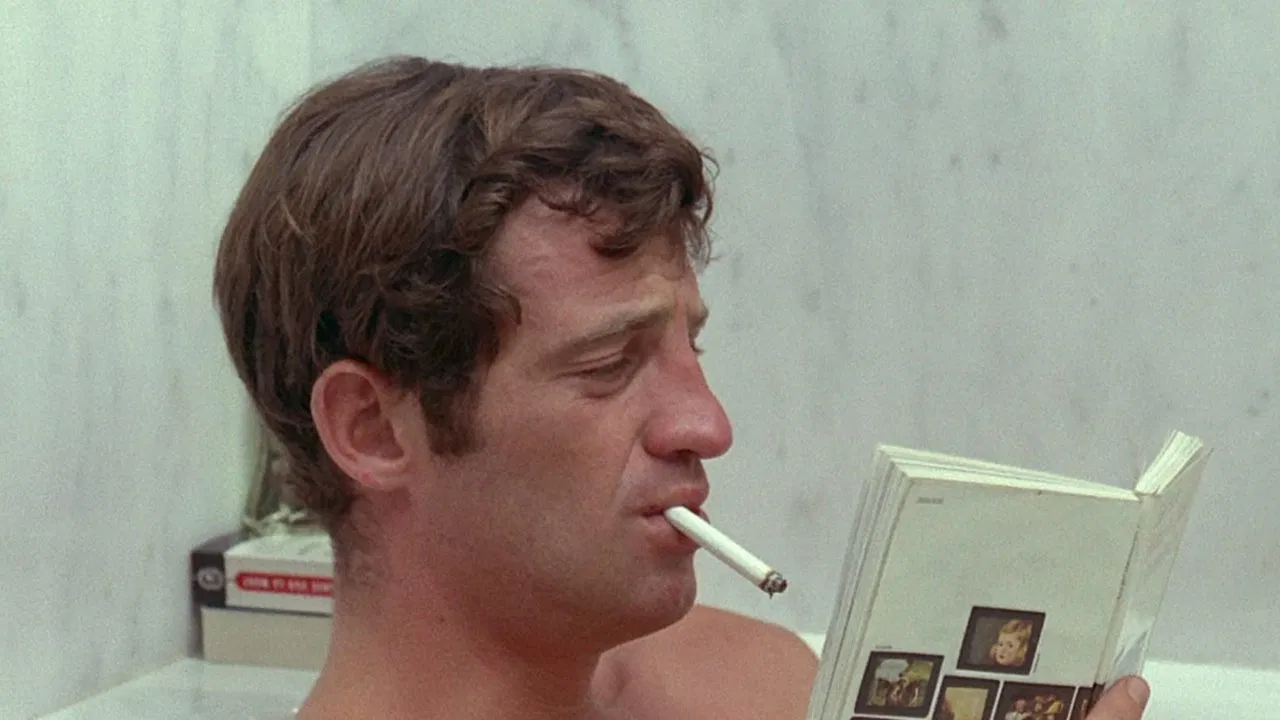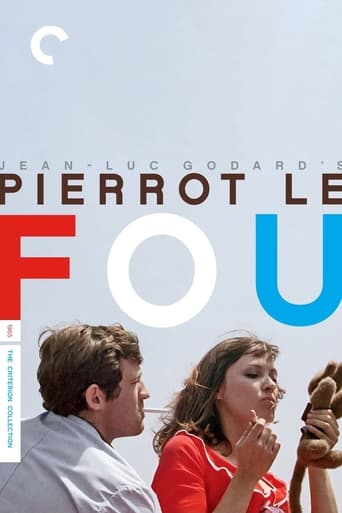

"I've never been able to appreciate any of his films, nor even understand them... I find his films affected, intellectual, self-obsessed and, as cinema, without interest and frankly dull... I've always thought that he made films for critics." That's Ingmar Bergman openly expressing his opinion about Jean- Luc Godard's movies, his 'contempt' to play on words.For a novice, this statement might sound awkward from a director whose movies aren't exactly devoid of intellectual material, except that Bergman and Godard don't play in the same league, the oeuvre of Bergman is far more monumental and substantial. Bergman approached in cinematic terms and hypnotic cinematography the human condition with a constantly questioned involvement of God, a brainstorm that spanned four decades of cinematic creation. What Godard offered is a questioning of cinematic (and storytelling) conventions, which he's entitled to do after all, except that by doing so, he confines his movies into the very cinematic medium they're supposed to free themselves out. Godard strikes like the rebellious teenage son of cinema, trying so hard to be different that it actually conditions him.That's Godard's paradox; the man who denounced the traditional cinema is perhaps the most cinematic of all directors, always indulging to a trick, a false connection, a disenchanted voice-over, a sudden change of color and many outbursts of spontaneity within the script, to prove that he exists, that he wouldn't let any cinematic requirement affect his work, that this movie we're watching is a movie, and he's the director. Many shots are creatively done and "Pierrot le Fou", for all its craziness, is a beautifully shot movie, in fact, Godard IS a talented film-maker and some scenes are absolutely mesmerizing, I especially love the little dance between Jean-Paul Belmondo and Anna Karina, it captures that idle casualness, that nonchalant free-spirited charm of youth in the 60's. But for one masterstroke like this, you have countless moments where you're just wondering "what the hell am I watching?".I know Godard is being deliberately awkward, sometimes for the sake of a gag (the film can be labeled as a comedy to some degree) or because of the "forbidding is forbidden" philosophy. But just because you do something deliberately doesn't make it any immune to criticism, it's only fair to determine to which extent the freedom of the director affects the appreciation of the story. And that's a parameter you wouldn't ignore unless you're wrapped up in a huge ego. To Godard's defense, I don't know if he held himself in such high esteem or if the cohort of fans didn't simply build the colossal monument out of his "Breathless" making any movie he'd make a masterpiece. Well, in 1965, I guess French youth was in demand of newness, something that would echo their rebellious spirit, something post- modern, and yes, I concede that "Pierrot le Fou" is far more interesting than "The Sound of Music", but that doesn't say much.Indeed, isn't it the height of irony that the post-modern masterpiece is now stuck to its era and became the true embodiment of the "Nouvelle Vague"? To be honest, I've never been a fan of the New Wave in the first place, I thought the movies that predated its beginning like "Bob le Flambeur", "Elevator to the Gallows", "400 Blows" were more interesting than the revolution itself, but when you look retrospectively, the New Wave was only the occasion for self-absorbed directors to prove how 'different' and modern they were. Time did justice to the French popular cinema of the 50's and 60's, and people would rather watch "The Sicilian Clan", "The Wages of Fear" or any gangster flick with Gabin and Ventura than these pseudo-intellectual, flashy movies. "Pierrot le Fou" exemplifies how hard creativity could damage credibility, it's Godard at its most intrusive, and it's a shame because the story had elements to grab the viewers.It's one of these romances on the lam with Ferdinand, a man struck in typical bourgeois ennui takes the control of his life, and escapes from his condition with Anna Karina, Belmondo has fun playing Ferdinand aka Pierrot, a role that allowed him to make a fool of himself, but Godard want to steal the actors' thunder instead of letting the two of them run the show, he uses them as puppets to the very statements he wants to make, or non-statement. I maintain that the New Wave's greatest achievement was to inspire the New Hollywood generation and when you look at "Bonnie and Clyde", "Badlands" or even "Sugarland Express", you can measure the differences between French and American cinema, one school is entrapped in its obsession with originality, another is busy telling the stories, one rejects the classics, another explores them and makes something fresh of it. Finally, one feels like cinema, one gets so experimental it's boring.And believe me, I gave it a third chance, I put it with the commentary on, with Godard's number-one fan talking, maybe he'd tell me things I couldn't see but he actually confirmed my suspicion, in every shot, it was "Godard did", "Godard defied", "Godard changed". Godard is the real star of the film, "Pierrot le Fou" proves that he's an iconoclast, twisted and certainly talented director, he just forgot that the essence of a movie is to plunge you in a world, tell you a story and make you forget it's movie, except if the self-referential aspect is central to the plot. Not a chance with Godard, he epitomized what's wrong with the New Wave, self-awareness, self- obsession confining to intellectual masturbation, self-selfism I want to say.The film isn't boring for all that and possesses a few moments of genuine tenderness and creativity, but Godard, once again, is being his worst enemy and destroys the very edifice he's building, for one scene that works, you have five or six leaving you scratching your head or wondering if you won't going to watch "Predator" instead.
... View MoreGodard is a pioneer in unstructured French movie-making. Despite the progress of a classical and chronological plot in Pierrot Le Fou, the way the story is told and the movie footage are quite novel. The story is told by two characters, cartoon inserts and literary references are as important as the scenes, Belmondo directly addresses the public, and the party in the beginning of the movie is shot like a moving fresco. The music has an abrupt ending, in such a way that one gets confused with the limits of the movie's reality and the fiction's reality. The result is a poetic movie shot in poetic light, and highlighted by poetic dialogues, but movie-making becomes a technical and intellectual reflection rather than a memorable and moving story.
... View MoreRegardless of what you will hear from pompous leftist professors in your Film Studies classes, kiddies, Jean-Luc Godard's "Pierrot le Fou" is really nothing more than an egotistical exercise in cinematic masturbation. That would be acceptable for a movie made for private viewing at home, but when it is released in public theaters it also becomes exhibitionism. Of course if you enjoy this kind of voyeurism it might be right up your alley, so to speak. All others should be warned. 'Ooh, look at me,' Godard seems to be saying. 'I'm an artiste, and a philosopher too! Not only can I juxtapose reality with surreality, I can be absurdist as well, with doses of deep Marxist commentary thrown in for good measure! Isn't that like, so cool, and revolutionary?" Uh, no. Not really, Jean-Luc.It is movies like this that give so-called "art house" films and filmgoers a bad name. When I overheard a couple of obnoxious self-styled cineastes analyzing and deconstructing the film afterwards with references to Roland Barthes and Jacques Derrida I almost wanted to puke.The best directors do not purposely draw attention to themselves, their craft or their directing style because they realize that, aside from documentaries, good filmmaking is primarily about one thing - telling a story in the best possible way. If you have to sit through this movie in Film Class bring a barf bag and some NoDoze. To cleanse your cinematic palate when you get home enjoy a movie made by directors like Frank Capra, Preston Sturges or even Clint Eastwood with a bag of popcorn or a box of Raisinets.
... View MoreLike much of Godard's work, "Pierrot le Fou" doesn't have much of a plot so much as a basic premise. Frenidand, bored and alienated by his robotic upper class peers, leaves a party on bad terms and runs into his still at home babysitter. He drives her home, and then the two start to fall in love. Then they run off, and the rest of the film is their misadventures.The film is filled with subversions and deconstructions. The soundtrack inexplicably stops and restarts throughout. Characters talk directly to the audience, and at points even just flat out say "the audience". The characters are well aware they're in a movie at points ("let's go back to the gangster picture"). There are a few musical numbers, though they are very low key, lacking the grandeur and choreography one would expect. In fact, I love the musical moments in this film because they are so low key and unobtrusive. Action sequences are truncated and undermined. The characters narrate, often telling the audience what the next chapter is, which is pretty much always despair, bitterness and hope. Godard is determined to tear down the curtain, to never let you forget you're watching a movie.Yet, all of these elements come together naturally. It never crosses into stupid pretentiousness. These elements only serve to enhance and give a new layer to a film that is still deeply compelling. Godard apparently didn't care to be sentimental (a lot of the European art directors don't care for that word) but sentimental is one way I'd describe the movie. Here we have two characters whose common ground is being unable to live in their current state of life: Fernindand because it's devoid of any intellectuality and passion, Marianne because she seems incapable of living in a steady life and becomes bored quickly. It's for this reason the two are drawn toward each other and run away together.Much of the film is made up of episodes, as the two end up on a "Bonnie and Clyde" style crime spree (a whole two years before the definitive Bonnie and Clyde movie made waves in the united states), robbing people and trying to stay one step ahead of the police as well as gangster Marianne has angered. The movie is very comedic in it's tone, and while it's easy to laugh at the absurdities of what you see, I found the most humor in the subversions and pot shots at cinematic tropes. In contrast though, you'll have the characters, whether in narration or talking to the audience (especially Fernidand) giving beautiful narration and monologues, punctuated by beautiful imagery (did I mention the film looks really good?). Their feelings for each other indeed begin being put to the test, as while the similarity brought them together, their differences start to bring them into conflict, shown when the characters are hiding out in a beautiful resort with nothing to do. When Marianne suggests going back to "the gangster picture", their crime spree, it makes clear that the distraction of danger and adventure may be what keeps them together.This blending of comedy and deconstruction with almost poetic resonance of feelings comes to ahead in it's ending, which I won't spoil, but needless to say it is both hilarious and touching.If you've seen any of Godard's other films, you have a good idea of what you're in for. If you've never seen a Godard film, this one might catch you off guard, but it's probably among his more easily accessible films.
... View More